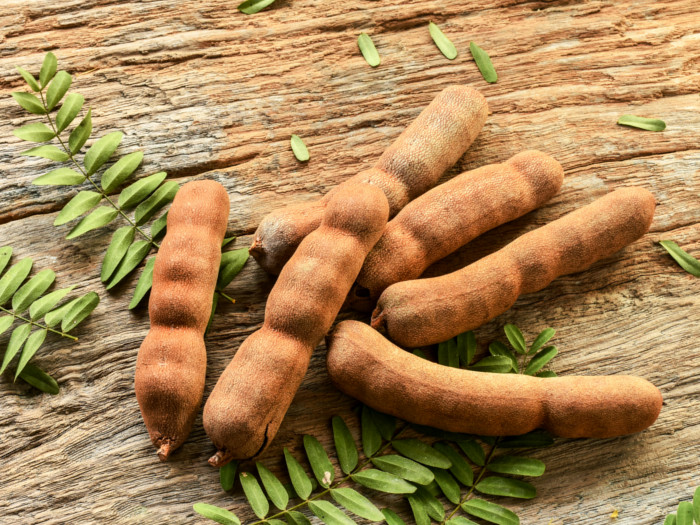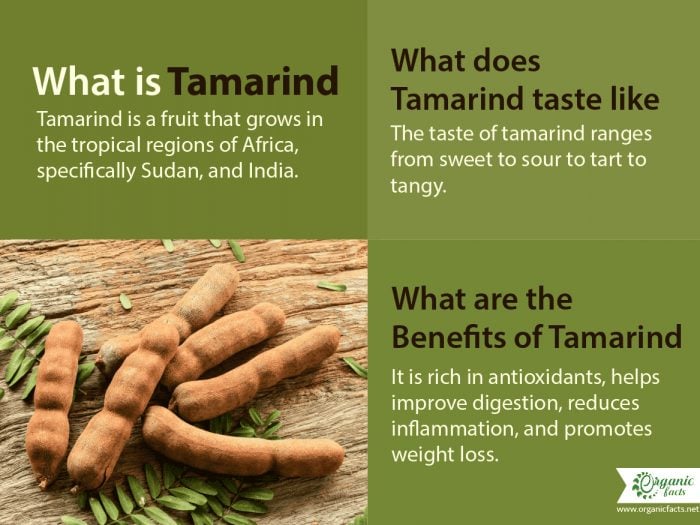Tamarind is a fruit that can help improve digestion. It is rich in antioxidants that can help protect your heart and it also can help reduce inflammation in your body. It can be also good for weight loss and may protect you against parasites and worms by boosting your immunity.
Table of Contents
What is Tamarind?
Tamarind is a tropical fruit and its trees are native to tropical regions of Africa, specifically Sudan. It grows in many regions like India and Pakistan. It is a member of the Fabaceae family and its scientific name is Tamarindus indica. The tree is a medium-sized bushy tree with evergreen leaves and a fruit that develops in pods. Its pods are characterized by long, brown shells. Inside the pods is sticky, fleshy, and juicy pulp, which is the tamarind fruit. This is where the nutrition and the taste reside! [14]
What Does Tamarind Taste Like?
The taste of tamarind ranges from sweet to sour to tart to tangy. It tastes like a date mixed with lemon and can make the back of your jaw tingle. For this very profile, it is used in many dishes that call for a zingy twist.
| Serving Size : | |
|---|---|
| Nutrient | Value |
| Water [g] | 31.4 |
| Energy | 239 |
| Energy [kJ] | 1000 |
| Protein [g] | 2.8 |
| Total lipid (fat) [g] | 0.6 |
| Ash [g] | 2.7 |
| Carbohydrate, by difference [g] | 62.5 |
| Fiber, total dietary [g] | 5.1 |
| Sugars, total including NLEA [g] | 38.8 |
| Calcium, Ca [mg] | 74 |
| Iron, Fe [mg] | 2.8 |
| Magnesium, Mg [mg] | 92 |
| Phosphorus, P [mg] | 113 |
| Potassium, K [mg] | 628 |
| Sodium, Na [mg] | 28 |
| Zinc, Zn [mg] | 0.1 |
| Copper, Cu [mg] | 0.09 |
| Selenium, Se [µg] | 1.3 |
| Vitamin C, total ascorbic acid [mg] | 3.5 |
| Thiamin [mg] | 0.43 |
| Riboflavin [mg] | 0.15 |
| Niacin [mg] | 1.94 |
| Pantothenic acid [mg] | 0.14 |
| Vitamin B-6 [mg] | 0.07 |
| Folate, total [µg] | 14 |
| Folate, food [µg] | 14 |
| Folate, DFE [µg] | 14 |
| Choline, total [mg] | 8.6 |
| Vitamin A, RAE [µg] | 2 |
| Carotene, beta [µg] | 18 |
| Vitamin A, IU [IU] | 30 |
| Vitamin E (alpha-tocopherol) [mg] | 0.1 |
| Vitamin K (phylloquinone) [µg] | 2.8 |
| Fatty acids, total saturated [g] | 0.27 |
| 14:0 [g] | 0.01 |
| 16:0 [g] | 0.17 |
| 18:0 [g] | 0.06 |
| Fatty acids, total monounsaturated [g] | 0.18 |
| 18:1 [g] | 0.18 |
| Fatty acids, total polyunsaturated [g] | 0.06 |
| 18:2 [g] | 0.06 |
| Tryptophan [g] | 0.02 |
| Lysine [g] | 0.14 |
| Methionine [g] | 0.01 |
| Sources include : USDA [15] | |
Tamarind Nutrition Facts
According to the USDA, raw tamarind can provide energy (calories) along with essential minerals like potassium, phosphorus, magnesium, calcium, iron, sodium, and zinc. It also contains vitamin C, B-vitamins (niacin, riboflavin, thiamin, folate), and vitamin A and K. [16]
Tamarind Benefits
The health benefits of tamarind are explained in greater detail below.
May Protect Heart Health
A study published in the Food and Chemical Toxicology journal has shown that tamarind may help in lowering LDL(bad) cholesterol. The fiber content in the sour fruit can help in scraping excess LDL cholesterol from the veins and arteries. [17] [18]
One more research published in 2013 found that the fruit pulp may exert its hypocholesterolemic effect by increasing cholesterol outflow, enhancing LDL cholesterol clearance, suppressing triglyceride accumulation, and inhibiting cholesterol biosynthesis. Moreover, it can also project light on the potential antioxidative effects of tamarind which can protect against high cholesterol. [19]
While many studies show that tamarind can be helpful for heart health, a 2020 research suggests otherwise. It was a randomized controlled trial conducted on overweight humans who were given 20 g of tamarind pulp every day. The results of this study show that there were no significant changes in the body weight, serum lipid profile, blood glucose, and blood pressure of these patients. However, experts are trying to get a more detailed look into this by changing a few factors like the quantity of dose and duration of the trial. [20]
May Improve Digestion
The tamarind fruit has long been considered a natural laxative, given its dietary fiber content. Eating it as a fruit or as a spice can increase the efficiency of your digestive system, as the insoluble fiber can bulk up your stool, making it move through the smooth muscles of the intestinal tract easily. It can also act as a bilious substance, meaning that it can stimulate the activity of bile and bile acids, which may aid in the absorption of fats and fat-soluble vitamins in the small intestine. [21]
This can ensure that food runs through your digestive tract smoothly, thus possibly making it a powerful laxative if you are suffering from chronic constipation. Tamarind also contains some soluble fiber which can have the opposite effect of insoluble fiber, can assist in reducing loose stools. Studies have shown the tropical fruit can be effective against chronic diarrhea as well.
Additionally, a study in Food Chemistry found that the soluble protein and amino-acid composition of the fruit make it the best digestive. [22]
May Aid In Weight Loss
A study published in the Scientia Pharmaceutica [23] journal suggests that tamarind water extract can help reduce obesity.
One of the unique compounds called trypsin inhibitors, found in tamarind, may help in reducing your hunger. This protein has been known to suppress the appetite by increasing the release of the neurotransmitter serotonin. Research is still ongoing in these respective areas, but the extracts of this fruit might show promising signs as a weight-loss supplement! [24] [25]

Adding a small slice of tamarind peel to curries can get you a tangy taste in them. Photo Credit: Shutterstock
May Help Manage Diabetes
A carbohydrate-heavy diet can increase the chances of uncontrolled glucose and insulin levels, which is a significant concern for those suffering from diabetes.
Tamarind can inhibit the enzyme alpha-amylase, which mainly stops carbohydrates from being absorbed in the body. It may help control these fluctuations as per a study published in the Journal of Ethnopharmacology. [26]
According to a study published in Nutrition Reviews, almost half (48 percent) of the US population consumed less than the required amount of magnesium from 2005-2006, which is the cause of various diseases including type-2 diabetes. Thus, the possibly high content of magnesium in tamarind may further help to prevent or alleviate diabetes. [27]
May Have Potentially Anti-inflammatory Capacity
Lupeol, found in tamarind leaves, possesses anti-inflammatory, according to a study done at the University of Wisconsin-Madison. [28] [29]
The essential oil of tamarind can be connected to several anti-inflammatory capabilities, probably including the reduction of joint pain and inflammation, arthritis, and gout. It may also reduce eye irritation – one of the most common forms of which is conjunctivitis, also known as pink eye. It has shown a definite soothing and anti-inflammatory ability and is, therefore, can be used in many herbal remedies for inflammation. [30]
May Boost Immunity
One study published in Elsevier’s LWT – Food Science and Technology journal sheds light on the potent antioxidant properties of tamarind. Antioxidants can make tamarind a wonderful way to boost your immunity, which can help to stave off microbial and fungal infections. It may also reduce the occurrence of parasites in the body due to its antiseptic and antimicrobial effects. It can be specifically linked to eliminating stomach worms in children in tropical areas where it is cultivated. [31] [32]

The taste of tamarind ranges from sweet to sour to tart to tangy. It tastes like a date mixed with lemon and can make the back of your jaw tingle.
How to Eat Tamarind?
There are many different ways to consume this nutritious fruit. It makes for a great base for many stews, chutneys, and marinades. Tamarind is used frequently in Asian, Mediterranean, and Middle Eastern cooking. Many culinary experts also recommend using it for tenderizing meat. Here are a few ways to include it in your diet.
- You can have it raw as a sour or sweet fruit but do keep in mind that it has a potent flavor. So, enjoy the tangy, sweet treat in moderation.
- You can add it to desserts and candy.
- While making soups or curries, you can add dried tamarind to them.
- Add tamarind to sauces like satay sauce for a tart flavor.
- You can add tamarind to Indian recipes like dal tadka, which is a type of lentil soup.
- Bring a savory flavor to your cooking by adding tamarind paste to it.
- You can also make tamarind juice at home by using this easy recipe.
Where to Buy Tamarind?
Tamarind is available in many forms like pods, paste, concentrate, and pulp. You can find it in Asian stores around you. If you are buying pods, you may have to go through the process of cleaning and deseeding them. You can buy a readymade pulp or paste if you do not have time.
Also, if you are unable to find it in any form, here are five alternatives you can use.
What are the Side Effects of Tamarind?
A moderate amount of this sour fruit is likely safe. However, there are a few side effects it can cause. Let’s have a look at them below.
- Blood Pressure: Tamarind may have the potential to lowers blood pressure so if you are already on a blood pressure medication, do consult with your doctor.
- Interaction with Medicines: Tamarind may have blood-thinning properties and it may also interact with medicines like aspirin. Do keep in mind to avoid using it in case you are on such medications.
- Diabetes: If you are suffering from diabetes, monitor the blood sugar levels closely when you consume tamarind. The best thing would be to consult with your doctor so that you can avoid unnecessary spikes and falls.
- Lead Poisoning: Many tamarind candy brands have been shown to contain more lead than specified by the US Food and Drug Administration (FDA) Level of Concern. So, we suggest you do research and educate yourself before buying these candies for yourself or your children. [33]
